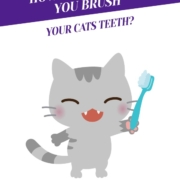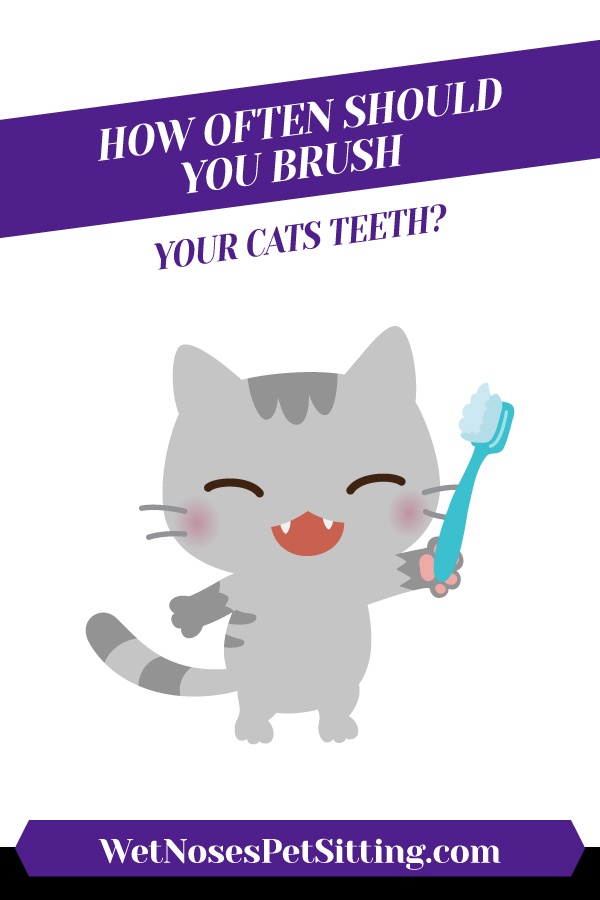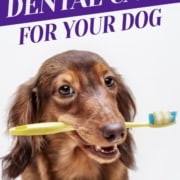How Often Should You Brush Your Cats Teeth?
How Often Should You Brush Your Cats Teeth?
It would be a pretty cool trick if you could actually train your cat to brush their teeth! Cats, however, don’t have thumbs or use their paws in the same manner as we do, so brushing their teeth is something that every pet owner should do.
Yearly professional dental checkups and cleanings are one of the essential steps to maintaining your cats overall health. When you keep their gums and teeth clean and free from plaque you are reducing the likelihood of bacteria and other teeth or gum problems becoming an overall health issue for your cat.
How often should you brush their teeth? In a perfect pet world “Daily” would be optimum. Most professionals will tell you that a few times a week is a great benefit though. So, before we get into the “how” of brushing your kitty’s teeth, let’s look at some of the more common problems unhealthy teeth and gums pose for your pet.
Bad breath also called ‘halitosis’ is the first indicator of a problem with your cat’s teeth. While the buildup of plaque on the teeth is one reason for this, other causes can be problems with the kidney’s or possibility of diabetes or other health issues. A yearly physical can rule these issues out.
Periodontal disease is the bacteria found in the plaque that builds up on your cat’s teeth and gum areas. This is formed when food debris along with this soft film of bacteria isn’t routinely cleaned off with regular cleaning by you. Tartar begins to harden and form below the gum line getting trapped and then eroding the varying structures that support the teeth. Around 70% of ALL cats have this by the time that they are three years of age!
Infections of the mouth often travel throughout your cat’s body. Other major health issues can link their cause to poor oral health. Abscesses can form and are very painful. When this happens it will require treatment that may include a root canal or complete removal of one or more of any affected teeth.
Oral cancer which incompasses the mouth area of the teeth, gums, tongue, or cheek can be discovered earlier through daily or weekly brushing by the pet owner.
Teeth reabsorption and fractured teeth are a real problem in older cats. With teeth reabsorption the outer layer of the tooth softens causing it to loosen many times below the gum line making it difficult for the pet owner to see and extremely painful for the cat. A reluctance to chew on one side or not at all could be an indication that you should have them checked by your veterinarian.
Any cat can develop a severe condition known as feline stomatitis. These are open inflamed ulcerations of your cat’s tongue, gums, and cheeks. There are a few breeds that are a bit predisposed to this such as Himalyans and Persians.
As your cat’s provider of all things essential to their well being, you can do some really important things to reduce or even prevent many of the above mentioned problems.
Brushing is one of them. There are cat foods that your veterinarian can recommend that can help slow down the buildup of plaque on your kitty’s teeth. Additives to water along with wipes for you to use on the teeth and gums are available as well. Ask your veterinarian about a dental sealant that they can apply after a dental cleaning.
Getting your cat to accept brushing their teeth should ideally start when they are a kitten. There are several choices on what to use such as a baby toothbrush that has very soft bristles, or one that fits over your finger as well as using a soft washcloth.
Using small square pieces of gauze also works for many cat’s who don’t like the other options mentioned above. Use ONLY a cat approved toothpaste as human ones have ingredients that can cause harm to their stomachs and gum tissues.
Begin by sitting quietly with your cat and rub their cheeks and mouth area. Most kitty’s really love this and starting with just one finger and then adding your other hand will ease your cat into accepting this portion of the teeth cleaning process.
Try dipping your finger into low sodium chicken broth or the water from canned tuna. Make sure that neither has onions or garlic as an ingredient. Let your cat lick this from your finger and gently rub it onto their gums. Next, apply your kitty toothpaste to that finger, let them lick this off and rub it gently onto their gums as well.
Now apply some paste to the toothbrush or other tool you will be using to scrub your kitty’s teeth. Gently lift the front lip and brush the teeth in the front. Be sure to give your cat plenty of positive reinforcement through rubs and taking the time to break up the brushing session.
Getting your cat comfortable with allowing you to brush their teeth will take some time. As cat parents know, our kitty’s do everything in their time. So don’t force anything and be sure to offer great incentives like catnip treats, or other yummy snacks!
I mentioned above that there are foods, wipes and other great products that can help you maintain great oral health in your cats. The Veterinary Oral Health Council (VOHC) has recommendations for the best products so check out their site for more information.
Wipes may be another option and easier for your cat to accept. By reading the reviews from other cat owners, you can decide if this will work for you and your cat.
Sealants are a great option as they are safe and painless for the cat. These are applied below the gum line after a good teeth cleaning by your veterinarian. Sanos brand lasts approximately six months after application. The overall condition of your cat’s gums and teeth along with the age of your kitty may require more frequent cleaning.
You will want to wait about seven days after application to resume your regular routine of brushing your cat’s teeth. If this sounds like something that you would like to use for your cat’s oral health, take the time to speak with your veterinarian to understand the procedure and benefits.
Taking care of your cat’s teeth is an important part of providing the very best care to ensure that they will remain healthy throughout their life! Invest the time to look at the different resources so that you can determine which products are the perfect choice for you and your kitty.






